Southwest Airlines is in the process of transforming its business model, under financial pressure from activist investors. The airline is changing just about everything, and has started charging for checked bags, adding basic economy, expiring travel credits, and more.
In July 2024, Southwest announced plans to introduce assigned and premium seating on flights, ending the carrier’s decades-old policy of having open seating. This feature has now been implemented for flights as of early 2026, so we have our first look at what pricing will be like…
In this post:
Southwest overhauls its seating policies
Southwest Airlines is introducing both assigned seating and premium seating. This new seating policy kicks in for flights as of January 27, 2026, with tickets under this new system now being on sale.
Southwest has already started reconfiguring aircraft with extra legroom seating, since obviously that can’t happen overnight. So while customers may already find themselves on planes with this new layout, the extra fees for the new model only apply for flights as of early 2026.
With the airline moving to a new seating model, all seats will be assigned, and over time, roughly one-third of seats across the fleet will offer extra legroom. As Southwest reconfigures jets, how will the layouts change? There will be three seating types:
- Extra legroom seats will be those at the front of the cabin, with extra legroom, as well as at exit rows
- Preferred seats will be those right behind the seats with extra legroom, and in front of the exit rows
- Standard seats will be those behind the exit row
For example, below is a seat map of the updated Southwest 737-800 and 737 MAX 8 configuration.
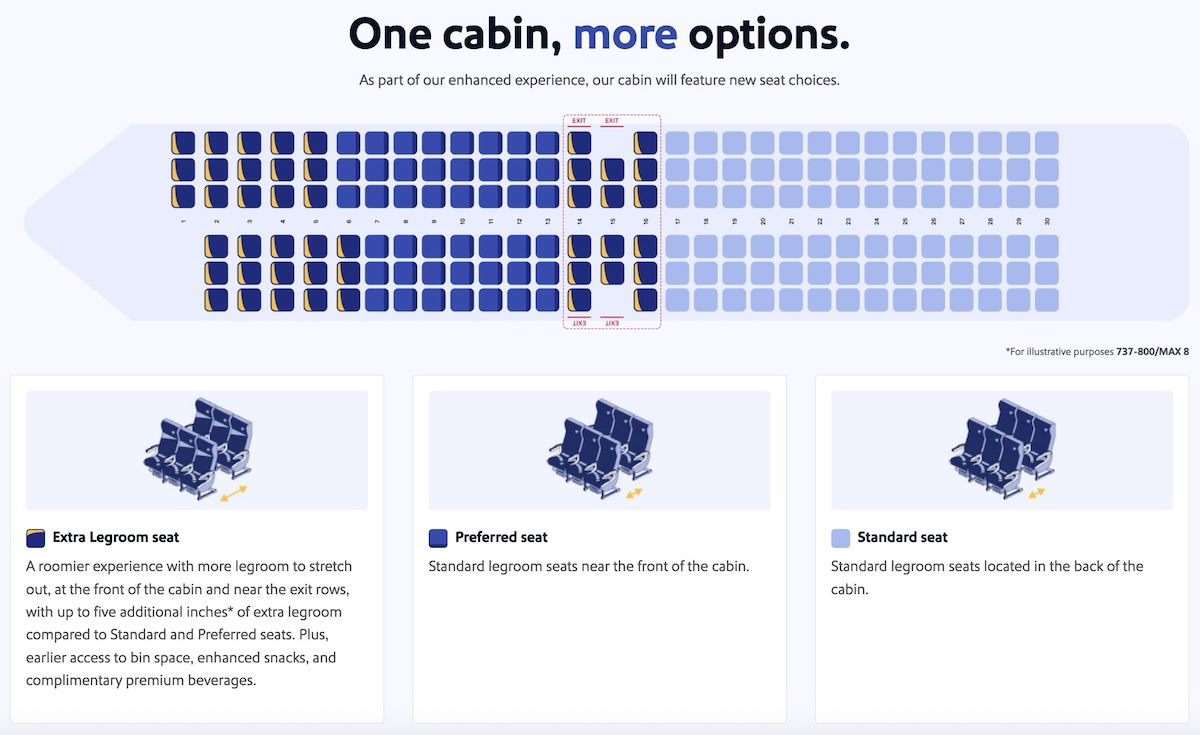
The expectation is that Southwest’s extra legroom seats will have 34″ of pitch, while standard seats will have 31″ of pitch. Essentially, 737-800s and 737 MAX 8s will have legroom reduced by 1″ for standard seats, in order to be able to add more legroom for other seats.
As you’d expect, Southwest Rapid Rewards A-List members and co-brand credit card members receive certain seating perks. The airline is also transforming its boarding process, with eight groups.
Southwest has been known for its unique open seating model for more than 50 years, but the airline believes that consumer preferences have evolved, with more customers taking longer flights, where a seat assignment is preferred.
Southwest claims that according to its research, 80% of Southwest customers and 86% of potential customers prefer an assigned seating concept. When a customer elects to stop flying with Southwest and chooses a competitor, open seating is cited as the number one reason for that.
With this change, Southwest believes it will broaden its appeal and attract more flying from its current and future customers. The airline states that this is part of the overall modernization efforts at the airline, and complements plans to introduce faster Wi-Fi, in-seat power, larger overhead bins, and more.
Here’s how Southwest CEO Bob Jordan described these seating changes, back when they were first announced:
“Moving to assigned seating and offering premium legroom options will be a transformational change that cuts across almost all aspects of the Company. Although our unique open seating model has been a part of Southwest Airlines since our inception, our thoughtful and extensive research makes it clear this is the right choice— at the right time—for our Customers, our People, and our Shareholders. We are excited to incorporate Customer and Employee feedback to design a unique experience that only Southwest can deliver. We have been building purposefully to this change as part of a comprehensive upgrade to the Southwest experience as we focus on Customer expectations – and it will unlock new sources of revenue consistent with our laser focus on delivering improved financial performance.”

Southwest assigned & premium seating pricing
With Southwest Airlines’ assigned and premium seating now live, what’s pricing like? To take a look, I pulled up an early 2026 flight from Tampa (TPA) to Fort Lauderdale (FLL), which is one of the carrier’s shorter routes.
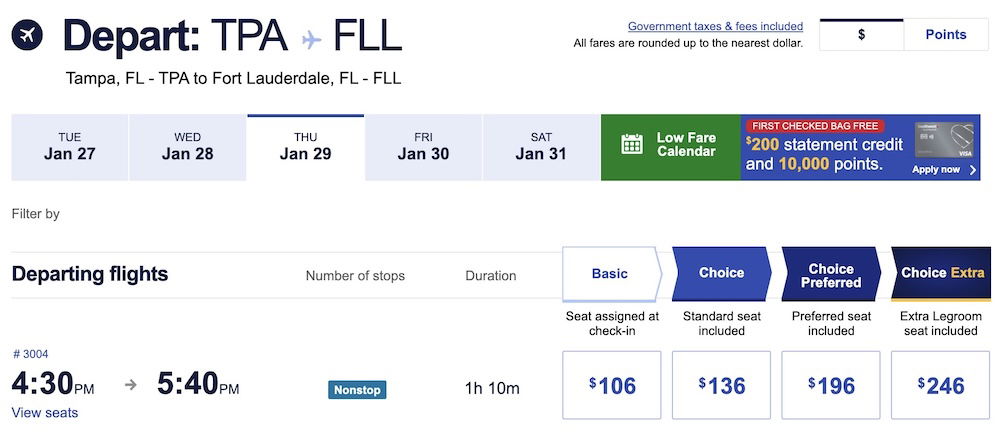
When booking the cheapest basic fare, seat assignments are only offered at check-in. Interestingly, you can’t even pay for a standard seat, but you can pay for a premium seat. The preferred seats range in cost from $23-26, while the extra legroom seats range in cost from $38-41.
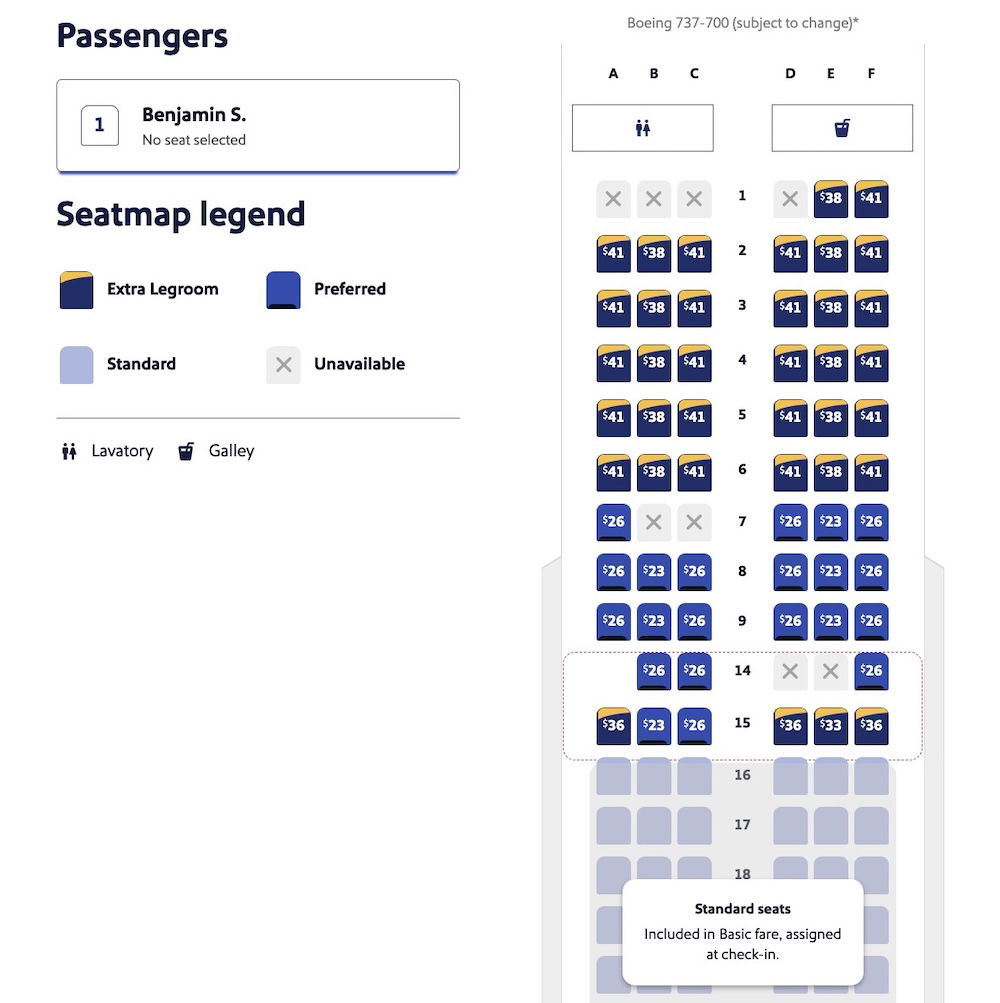
I then pulled up an early 2026 flight from Baltimore (BWI) to Los Angeles (LAX), which is one of the carrier’s longer routes.
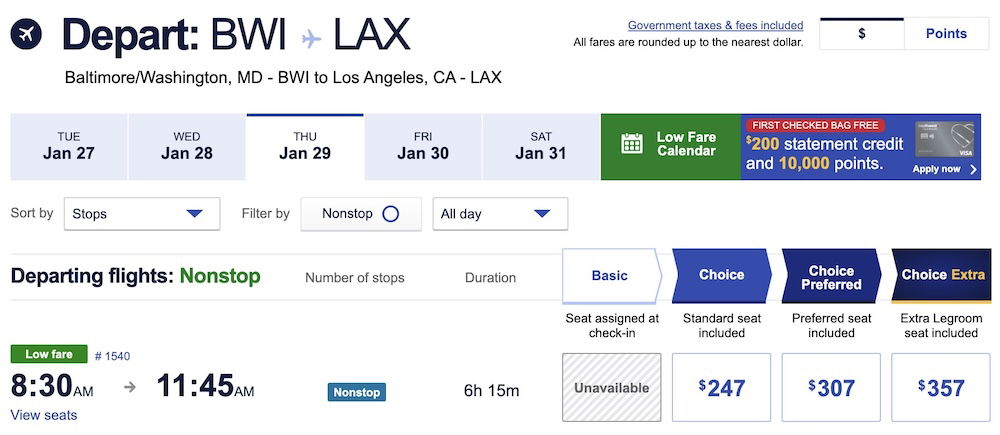
When booking the cheaper choice fare (basic fares weren’t available), standard seat selection was included. The preferred seats range in cost from $36-41, while the extra legroom seats range in cost from $83-91.
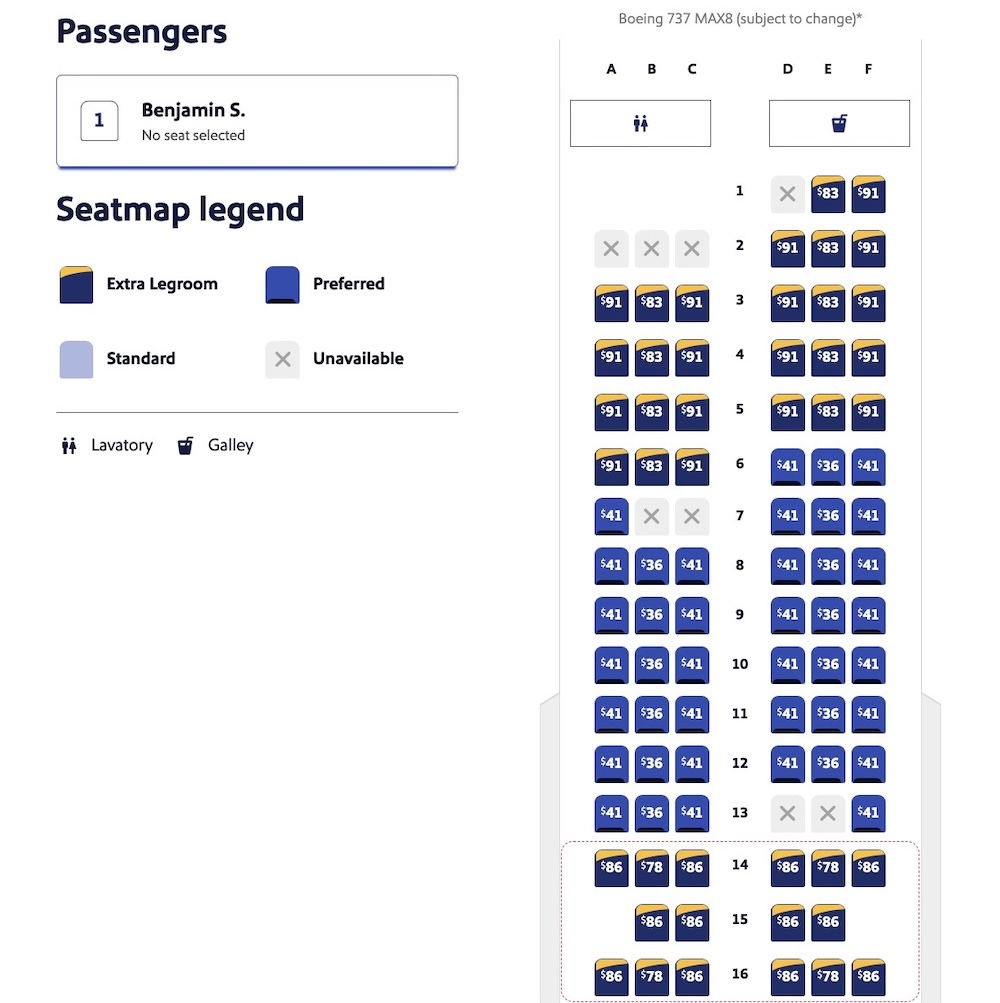
As you can tell, this pricing is dynamic, and will vary over time, I imagine. The thing that initially stands out to me the most is how little the pricing differs within each section, and between aisle seats and middle seats. I imagine that will change over time, to reflect consumer behavior.
One other thing that stood out to me is that the whole Southwest booking process now feels a lot more like booking with an ultra low cost carrier. There are lots of upsell opportunities, questions about whether you’re sure you don’t want to upgrade your fare type, etc.
These Southwest changes were inevitable
I don’t think it should come as a surprise to anyone that Southwest Airlines is finally updating its onboard seating model.
For decades, Southwest was one of the most profitable US airlines, but the carrier has lost its financial edge, as consumer travel patterns have shifted (for that matter, the industry has shifted more fundamentally). Southwest isn’t able to capitalize on the premium travel boom, plus the demand for long haul travel. The airline also hasn’t been able to generate as much ancillary revenue as competitors, which is a major source of profits for airlines.
So over the past year or so, we’ve seen Southwest management essentially take an axe to the carrier’s business model and passenger experience. Now, as far as Southwest’s changes go, I actually think introducing assigned and extra legroom seating is among the more sensible updates we’re seeing. Assigned seating is much easier to monetize, and also less frustrating for many passengers, since they know exactly what they’re going to get.
As far as premium seating goes, that also makes perfect sense. In early 2024, Southwest unveiled new cabins, which are being installed on newly delivered aircraft. What’s interesting is that these seats are thinner than previous seats, yet Southwest claimed from the beginning that it wouldn’t increase the number of seats on planes. So it also makes sense that we’re seeing the introduction of seats with extra legroom.
Airlines aren’t charities (even if their balance sheets may at times suggest otherwise), so it makes sense that Southwest would try to monetize the extra space, and change the cabin layout a bit.
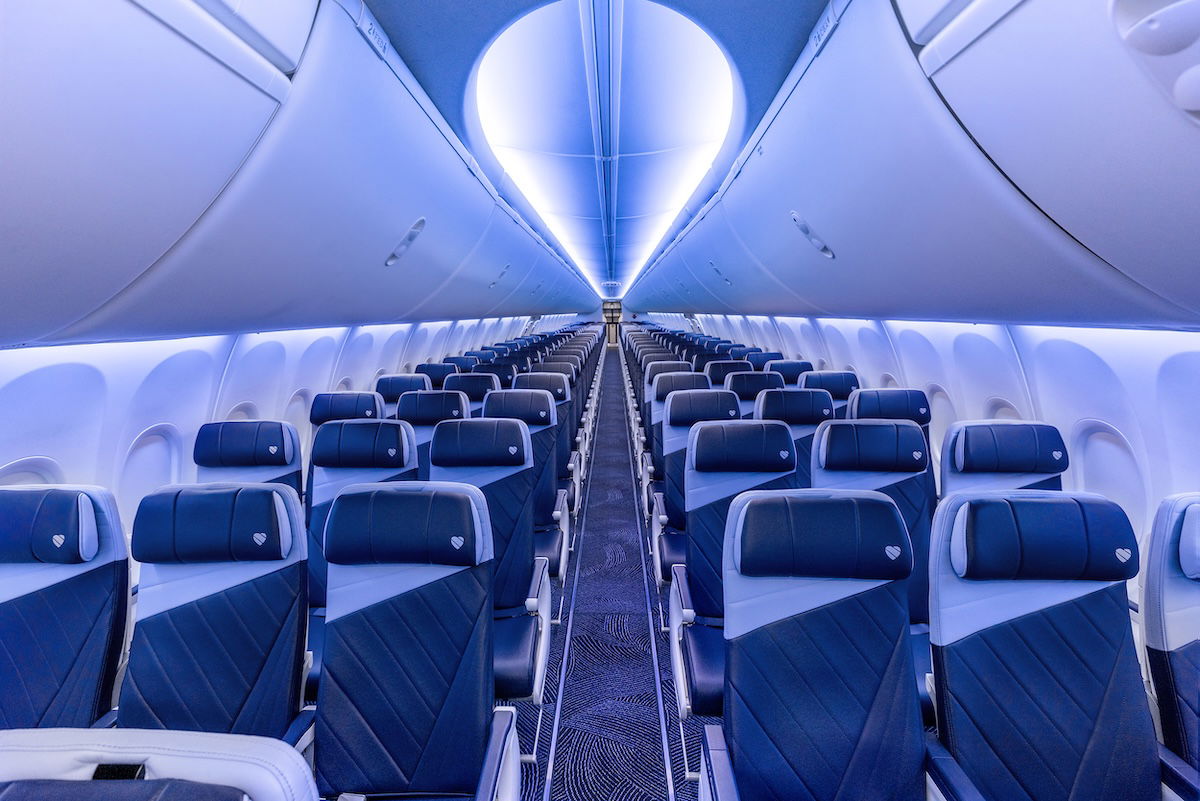
Bottom line
Southwest Airlines is introducing assigned seating on all flights, and also plans to introduce a premium seating option, with extra legroom. Tickets under this new model are now on sale, for flights as of January 27, 2026.
This evolution at Southwest was bound to happen, given the carrier’s current financial performance. I’d say the implementation of this new model is roughly what we were expecting, though we’ll see how it evolves over time.
What do you make of Southwest introducing assigned and premium seating?





Am I just not fully awake yet? It looks like it is less expensive to select the least expensive rate bucket then pay for the seat you want in the higher rate bucket section. For first flight, Basically is $106. Extra leg room aisle seat is $41. Total price of $147 vs listed bucket price of $246. Someone in revenue management messed up big time.
Not all SW flights show assigned seating. I ran into a couple of city pairs, in January 2o26, where the seat map showed open seating (with early bird check-in for a fee). Other city pairs, on the same dates, did offer assigned seats.
With legacy airlines having basic economy fares that compete with the so called low cost carriers and the changes at SW now make SW like any of the others. Consider that many of the so called low cost carriers have been hit from legacy carriers introducing basic fares. The only reason people will choose it going forward is possibly access to some alternative airports
Purely looking at the numbers the Southwest business model was not working and was becoming a frustration for many of it's loyal passengers. You pay for Group A just to have a bunch of jetway Jesus fakers and their low rent family/friends take up all the window and aisle seats, particularly towards the front of the plane?
Southwest was getting hammered from ULCCs below it (albeit that business model is turning into a turd) and...
Purely looking at the numbers the Southwest business model was not working and was becoming a frustration for many of it's loyal passengers. You pay for Group A just to have a bunch of jetway Jesus fakers and their low rent family/friends take up all the window and aisle seats, particularly towards the front of the plane?
Southwest was getting hammered from ULCCs below it (albeit that business model is turning into a turd) and the US3 on the top. Whether this is the right strategy remains to be seen but something different needs to be tried.
Amen. Hopefully this ends the beyond obnoxious culture of entitled seat saving.
WN's previous (fading) business model didn't work. They certainly don't have the advantage of being distinctive that they once had but the number of people that argue about no longer flying WN are very likely the customers that WN doesn't need.
Real fare paying customers don't have any better choices anywhere else. WN is not a small airline that has no market strengths. They will win or lose based on the same factors that...
WN's previous (fading) business model didn't work. They certainly don't have the advantage of being distinctive that they once had but the number of people that argue about no longer flying WN are very likely the customers that WN doesn't need.
Real fare paying customers don't have any better choices anywhere else. WN is not a small airline that has no market strengths. They will win or lose based on the same factors that determine success in any other airline consumer price - schedule and total fare.
and it isn't exactly like the big 3 figured out the exact balance of ancillary seating on day 1.
the bigger issue facing WN is that the overall economy has to improve to support the number of carriers that are competing for the same economy passenger. there are other airlines that are far more at risk of failure than WN is which has one of the industry's strongest balance sheets.
I think what is silly about this whole thing is that WN didn’t have a bad model. I think what happened here is 1 simple thing. WN is the largest domestic airline in the US and domestic traffic has been more or less terrible post-COVID. In this low margin industry, of which domestic economy travel is the lowest end of margins, WN was the most impacted of the big 4. What I continue to laugh...
I think what is silly about this whole thing is that WN didn’t have a bad model. I think what happened here is 1 simple thing. WN is the largest domestic airline in the US and domestic traffic has been more or less terrible post-COVID. In this low margin industry, of which domestic economy travel is the lowest end of margins, WN was the most impacted of the big 4. What I continue to laugh about is that of course seat selection is the top reason people say they’re going to change precisely because that’s the biggest difference between WN and the other 3 carriers.
DL an UA of course have smaller domestic operations but also have a ton of premium capacity on international flights that helped them pad their margins. AA meanwhile had someone with lets say ‘interesting’ ideas running their revenue org who, among other ‘interesting’ decisions, thought to simplify the fleet and get rid of a huge amount of premium seats. Maybe they weren’t the nicest seats but AA certainly did not have the same benefit that DL and UA did post-COVID. Think of how many more people could have flown to LHR, CDG, and MAD, had AA kept those planes!
In summary, I think WN simply got the shaft due to more domestic capacity than demand. Assigned seating will level the playing field somewhat, but capacity vs demand was the core of WNs problem.
you came to the right conclusions but you miss some key facts.
first, DL flies more domestic ASMs on its own metal than WN does. DL has much longer domestic flights than WN even though WN operates more flights. UA has the smallest domestic system of the big 4 on the same basis.
Seat assignments matter much more on longer flights. People can and do put up w/ a middle seat when they are...
you came to the right conclusions but you miss some key facts.
first, DL flies more domestic ASMs on its own metal than WN does. DL has much longer domestic flights than WN even though WN operates more flights. UA has the smallest domestic system of the big 4 on the same basis.
Seat assignments matter much more on longer flights. People can and do put up w/ a middle seat when they are only on a plane for an hour or two.
WN's flights have been getting longer and longer in part because they don't have the costs to profitably operate lots of short flights - a result of becoming an older carrier w/ fewer lower seniority employees.
AA did get rid of too many airplanes but they also cheapened the product and fled from highly competitive but also strategically necessary markets like NYC, CHI and LAX. In order to compete for corporate revenue, you have to serve major competitive markets. AA's loss of aircraft was relatively minor in the scope of where they are. DFW and CLT can only do so much for a carrier as large as AA.
WN's former model just didn't generate the revenue that WN needed. WN's idea that everyone should be treated the same sounds nice but it costs alot of revenue when human nature shows that some people want to be treated better and are willing to spend money to distinguish themselves. the big 3 started a trend that WN couldn't resist because the fundamental basis of WN's product - egalitarianism - can't compete against raw capitalism
and, yes, WN needs to see a turnaround in overall domestic demand but according to multiple airlines that is happening in the 2nd half of the year along w/ pulling a small amount of capacity out of the US airline system
@ DFW Flyer
@ Tim Dunn
Part of WN problem is the B737MAX especially the B737-7
Prior to 2017/2018, before the EIS of the MAX, WN fleet largely consisted of the smaller B737-700. The majority of their order was for the smallest MAX but since 2021, in the absence of the B737-7, they have converted some of their order to the B737-8, which is actually to big for the core route structure they have.
that is exactly right.
They not only failed to adapt to the changing market but they have been forced to fly too many seats as a result of Boeing's failures to delivery the MAX 7
now they are starting to wonder if they really should take the MAX 7 given that the MAX 8 is much more efficient per seat.
They have to pivot to another aircraft at some time so participating in industry consolidation...
that is exactly right.
They not only failed to adapt to the changing market but they have been forced to fly too many seats as a result of Boeing's failures to delivery the MAX 7
now they are starting to wonder if they really should take the MAX 7 given that the MAX 8 is much more efficient per seat.
They have to pivot to another aircraft at some time so participating in industry consolidation with a player like Breeze or JetBlue would provide the A220-300 and potentially give WN a seat at the table when the A220-500 is released.
@DFW Flyer WN did not have a bad model but we are in crunch time for corporations to maximize their value to shareholders. If you ask certain technicians, the DJIA could easily hit 100k by the end of the decade (we are essentially at 1995 again, unless the unpredictability/volatility of the Trump administration's economic approach gets out of hand). So WN had to make some big decisions to ensure future upward momentum in stock price....
@DFW Flyer WN did not have a bad model but we are in crunch time for corporations to maximize their value to shareholders. If you ask certain technicians, the DJIA could easily hit 100k by the end of the decade (we are essentially at 1995 again, unless the unpredictability/volatility of the Trump administration's economic approach gets out of hand). So WN had to make some big decisions to ensure future upward momentum in stock price.
Why anyone would even mess with airlines (the lowest of the cyclicals) when big tech is once again a gold rush, is beyond me though. Sitting here watching the MSFT stock I bought for $27 in 2010 hit $551 in after-hours trading. Woot.
I agree. And honestly, with the MAGA own-goal through the Big Billionaire Bill and Trump's wacko tariff policies, that market shift may be coming sooner than they projected.
WN was never "cheap" albeit their FAs were definitely more "cheerful" than the mainline carriers.
There was a reason why WN flights did not show on on flight search engines. They didn't want you to realize that the WN flights were often more expensive than other carriers.
@Kaleb_With_A_K
Yes, Southwest wasn't always the cheapest. They definitely weren't Spirit/Frontier in terms of fares. As somebody based in ATL, I often saw AA undercutting them. The value came from free checked bags, no paid seat selection/upcharge for the privilege to select a seat, which made them marginally cheaper than Delta most of the time and they'd often be much cheaper when going between Southwest hubs or to secondary airports like BWI, HOU, or MDW.
The 'activist' investor behind all of this is a turd.
"Airlines aren’t charities", but with nothing to distinguish it, Southwest has just become a utility. You only choose it because either you don't have a choice on a particular route or it has the lowest fare on that route.
So what’s the point again of flying Southwest now over say somebody like Delta? Why does Southwest hate bags so much now? What did the bags ever do to them?
There is no reason at all to fly WN over a mainline carrier unless WN offers non-stop flights (or flies to a destination not served).
On the other hand the mainline carriers are doing better than WN